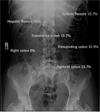Internal anal sphincter relaxation associated with bisacodyl-induced colonic high amplitude propagating contractions in children with constipation: a colo-anal reflex?
- PMID: 22757618
- PMCID: PMC3465462
- DOI: 10.1111/j.1365-2982.2012.01965.x
Internal anal sphincter relaxation associated with bisacodyl-induced colonic high amplitude propagating contractions in children with constipation: a colo-anal reflex?
Abstract
Background: Describe the association of internal anal sphincter (IAS) relaxation with colonic high- amplitude peristaltic contractions (HAPCs).
Methods: Retrospective review of colon manometry tracings of children with constipation to determine the IAS relaxation characteristics associated with HAPC's (HAPC-IASR) events and compare them to the those seen during the performance of the anorectal manometry (ARMRAIR) events.
Key results: A total of 70 HAPC- IASRs were observed in 15 patients, 65 after bisacodyl, two during fasting and three after a meal. In 64% of events, the IAS relaxation started when the HAPC reached left colon and in 36% as proximal as the hepatic flexure. High- amplitude peristaltic contraction propagation seems to be important in HAPC-IASR characteristics; those propagating distal to sigmoid colon demonstrated larger and longer IAS relaxation as well as lower residual pressure, but equivalent resting pressure compared with HAPC's ending proximal to sigmoid colon. Although IAS resting pressure was comparable for ARM-RAIRs and HAPC-IASRs, the duration and magnitude of anal relaxation was higher, and the anal residual pressure was lower in HAPC-IASRs.
Conclusions & inferences: We demonstrated that IAS relaxation in constipated children is associated with HAPCs migrating in the proximal and distal colon; in most cases, starting when peristalsis is migrating through left colon and in an important proportion while migrating proximally. We also demonstrated that HAPC-IASRs are different from ARM-RAIRs suggesting a neurally mediated reflex. Finally, the IAS relaxation characteristics are highly dependent on the degree of propagation of HAPCs, which could have important implications in the understanding of defecation disorders.
© 2012 Blackwell Publishing Ltd.
Figures





Similar articles
-
Preservation of the colo-anal reflex in colonic transection and post-operative Hirschsprung's disease: Potential extrinsic neural pathway.Neurogastroenterol Motil. 2019 Jan;31(1):e13472. doi: 10.1111/nmo.13472. Epub 2018 Oct 4. Neurogastroenterol Motil. 2019. PMID: 30288858
-
Characterization of the colonic response to bisacodyl in children with treatment-refractory constipation.Neurogastroenterol Motil. 2020 Aug;32(8):e13851. doi: 10.1111/nmo.13851. Epub 2020 Apr 13. Neurogastroenterol Motil. 2020. PMID: 32281199
-
Coloanal motor coordination in association with high-amplitude colonic contractions after pharmacological stimulation.Am J Gastroenterol. 2000 Mar;95(3):715-9. doi: 10.1111/j.1572-0241.2000.01840.x. Am J Gastroenterol. 2000. PMID: 10710063
-
High amplitude propagated contractions.Neurogastroenterol Motil. 2012 Nov;24(11):977-82. doi: 10.1111/nmo.12019. Neurogastroenterol Motil. 2012. PMID: 23057554 Free PMC article. Review.
-
Update of tests of colon and rectal structure and function.J Clin Gastroenterol. 2006 Feb;40(2):96-103. doi: 10.1097/01.mcg.0000196190.42296.a9. J Clin Gastroenterol. 2006. PMID: 16394868 Review.
Cited by
-
Role of daily anal stimulation for intractable functional constipation in infants.World J Pediatr Surg. 2020 Jul 3;3(2):e000135. doi: 10.1136/wjps-2020-000135. eCollection 2020. World J Pediatr Surg. 2020. PMID: 36474916 Free PMC article.
-
First translational consensus on terminology and definitions of colonic motility in animals and humans studied by manometric and other techniques.Nat Rev Gastroenterol Hepatol. 2019 Sep;16(9):559-579. doi: 10.1038/s41575-019-0167-1. Epub 2019 Jul 11. Nat Rev Gastroenterol Hepatol. 2019. PMID: 31296967 Free PMC article. Review.
-
The Sphincter of O'Beirne-Part 2: Report of a Case of Chronic Constipation with Autonomous Dyssynergia.Dig Dis Sci. 2021 Oct;66(10):3529-3541. doi: 10.1007/s10620-020-06723-3. Epub 2021 Jan 19. Dig Dis Sci. 2021. PMID: 33462747
-
On the nature of high-amplitude propagating pressure waves in the human colon.Am J Physiol Gastrointest Liver Physiol. 2020 Apr 1;318(4):G646-G660. doi: 10.1152/ajpgi.00386.2019. Epub 2020 Feb 18. Am J Physiol Gastrointest Liver Physiol. 2020. PMID: 32068445 Free PMC article.
-
Intraluminal pressure patterns in the human colon assessed by high-resolution manometry.Sci Rep. 2017 Feb 20;7:41436. doi: 10.1038/srep41436. Sci Rep. 2017. PMID: 28216670 Free PMC article.
References
-
- Kamm MA, van der Sijp JR, Lennard-Jones JE. Observations on the characteristics of stimulated defaecation in severe idiopathic constipation. Int J Colorectal Dis. 1992;7:197–201. - PubMed
-
- Malcolm A, Camilleri M. Coloanal motor coordination in association with high-amplitude colonic contractions after pharmacological stimulation. Am J Gastroenterol. 2000;95:715–719. - PubMed
-
- Kamm MA, van der Sijp JR, Lennard-Jones JE. Colorectal and anal motility during defaecation. Lancet. 1992;339:820. - PubMed
-
- Di Lorenzo C, Flores AF, Reddy SN, et al. Use of colonic manometry to differentiate causes of intractable constipation in children. J Pediatr. 1992;120:690–695. - PubMed
Publication types
MeSH terms
Substances
Grants and funding
LinkOut - more resources
Full Text Sources
Medical

